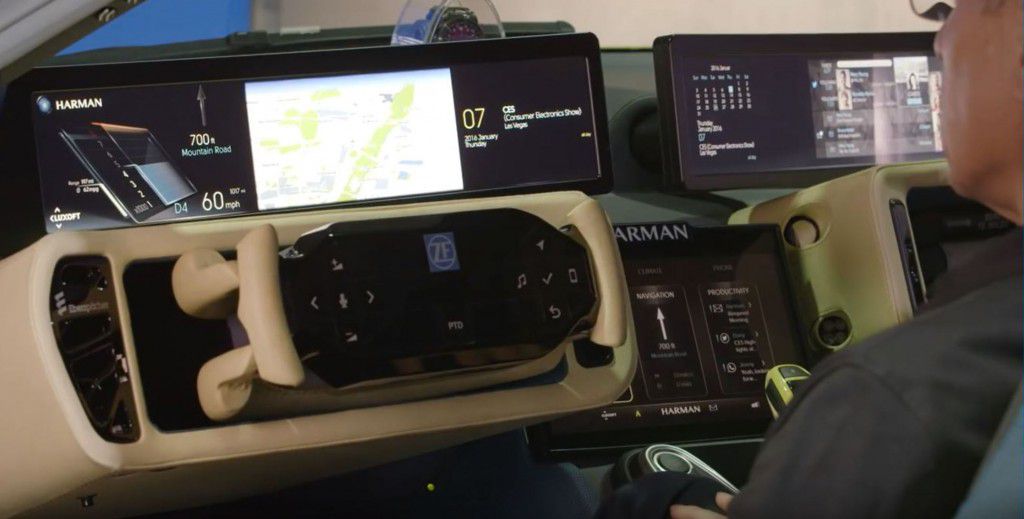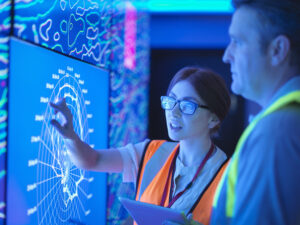Enabling the Connected Car
The Record Issue 1: Summer 2016
Digital technologies are enabling a new level of connectivity and mobility for drivers and automotive manufacturers alike. We speak to Microsoft’s Sanjay Ravi and Rohit Bhargava to find out more.

Today’s consumers rely on technology in almost every aspect of their lives, expecting connectedness and mobility at previously unprecedented levels. This shift is being driven by a digital transformation that is having a huge impact on our home and working lives. Now the principles of this digital transformation are beginning to have an impact in a new area – the car.
“The automotive industry is going through a significant digital business transformation,” says Sanjay Ravi, worldwide managing director for discrete manufacturing: high tech, automotive, aerospace and industrial at Microsoft. “The traditional products that were sold by automotive manufacturers are changing thanks to the advent of connected vehicles, autonomous vehicles, advanced driving assistance systems and electric vehicles. The car is becoming a device that is part of the digital life of the consumer. and manufacturers can leverage the connectivity in the vehicle to keep an ongoing relationship with the car owner. Both of these represent a significant change.”
Consumers expectations are altering, and a seamless experience while at home, in the car or at work is in greater demand than ever before.

“From a consumer perspective, the notion of the mobility experience is becoming pretty rich and will span across home, car, work and across multiple devices,” explains Ravi. “When it comes to this experience in the car, the business model needs to deliver an entertaining experience when in the car, in a safe way of course, and the ability to be productive in the car.”
The increasing connectivity of the modern car can enable integration with other ‘smart’ ecosystems, such as vehicle to infrastructure, vehicle to X, smart home, or even vehicle to vehicle communication.
“This is where the industry is evolving, and automotive companies can take advantage of the opportunities that are there,” says Ravi. “They should expand their focus from just manufacturing and selling a car to going after the broader smart mobility services opportunities.”
Ravi says that the creation of new paradigms around how technology is used are necessary in order to accelerate these new digital services and business models. With more competition in this connected world, traditional vehicle manufacturers must respond.
“The beauty of intelligent car applications is that they can be aware even when the person isn’t in the car,” says Rohit Bhargava, Microsoft’s chief technology officer for worldwide discrete manufacturing, enterprise and partner group. “They can inform a user that traffic is heavy and alert the user as to when they should start their journey. This is an example of the user’s digital life fusing with the intent of mobility provided by the vehicle.”
Once inside a connected car, users can choose to be productive by easily conferencing into meetings, or stay informed about their most important e-mails using voice interaction.

“When we surface important e-mails, there’s a lot of intelligence behind that,” Bhargava explains. “Who sent that email? Are they within your immediate team or hierarchy? Or an important customer? Microsoft provides platform capabilities in the cloud such as Office graph which ranks the importance of documents and who they are from, among other criteria. These capabilities can be brought to the car in innovative ways to enable productivity scenarios while respecting the driver’s constraints to keep their eyes on the road and hands on the wheel.”
But productivity need not be limited to conferencing and emails. Reminders can be set within the home or office environment via an intelligent personal assistant, such as Cortana, to help drivers complete their everyday tasks by seamlessly transferring the context to the vehicle. This completion of the tasks during the course of the journey.
Furthermore, when a journey is completed, the connected car can share the vehicle status with users, such as how much fuel is left and where the car is parked via a seamless link between the car, the cloud, and any of the user’s devices.
Manufacturers can also capitalize on the connected car concept. Thanks to data telemetry from the car to the cloud, data analytics can monitor the ‘health’ of a vehicle. Every element of the car can be accessed via sensor technology, which then send data to the cloud, where advanced analysis using techniques like machine learning delivering vital insights about the vehicle fleet to car makers.
“If a condition is detected early, it becomes possible for a dealer to proactively contact the owner so that they can fix the fault before it gets worse,” Bhargava explains. “Data and advanced analytics allows for proactive intervention ahead of potential failure.”
With the aid of fine grained data collection and advanced analytics, automotive original equipment manufacturers can also understand what features are being used, by what demographic, in what region, for their fleet thanks to advanced sensor technology. This information can help inform sales and marketing campaigns, and benefit manufacturing and the supply chain.
Microsoft has a number of long-established partnerships in the automotive space. At this year’s //build developer conference, BMW announced it was leveraging the Azure cloud platform to provide an end-to-end customer experience that puts the consumer at the center. Similarly, at the 2016 Consumer Electronics Show, Harman and Microsoft announced a collaboration to help streamline functionality between Harman Connected Car Systems and Microsoft Productivity Services.
“Microsoft is providing the global cloud platform, the connectivity and the data analytics together with machine learning that delivers most of the capabilities that are required here,” says Bhargava. “As car makers transform into digital enterprises, they need a common platform that can offer services that extend their reach to vehicles and customers globally. Microsoft offers a global footprint and secure connectivity, together with one of the most comprehensive and global cloud and analytics platforms that can support the digitalization needs of the largest enterprises.”





